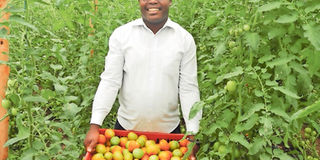Secrets from tomato man with 6,000 plants

Rono harvests tomatoes inside one of his greenhouses. A one-time large wheat farmer, he has now found his footing in greenhouse tomato farming. PHOTO | VITALIS KIMUTAI | NMG
What you need to know:
- Rono, a one-time large wheat farmer, has found his footing in greenhouse tomato farming, having made the switch in 2016.
- Rono ploughed Sh350,000 as he embarked on horticulture farming, with the money going on a greenhouse measuring 40 by 16 metres, a water tank, seeds, a water pump and labour.
- He constructed the second greenhouse in December last year and planted seedlings in March. In total, he grows some 6,000 plants inside the greenhouses.
- Festus Cheruiyot, an agricultural economist at Bomet County, says diseases and pests are one of the biggest headache for farmers in the business.
A few kilometres from Mulot Trading Centre in Kilusu village, Narok County, stand two large greenhouses on a quarter-acre farm.
Geoffrey Rono, the owner of the farm, is tending to his tomato plants inside the greenhouses when we meet him.
Two of his employees are busy harvesting ripe fruits and putting them in crates, before ferrying them out of the greenhouse for grading.
Rono, a one-time large wheat farmer, has found his footing in greenhouse tomato farming, having made the switch in 2016.
“I planted 70 acres of wheat and made some little profit and I was encouraged to increase the acreage to 150 acres only to burnt my fingers. I gave up altogether.”
Before going into tomato farming, Rono visited a number of farmers in Kajiado County to get tips on the agribusiness.
“Most of the greenhouses I saw during the trip were constructed using metal bars, but I chose to use timber and wooden poles in my unit as they are cheap and locally available,” Rono says.
Rono ploughed Sh350,000 as he embarked on horticulture farming, with the money going on a greenhouse measuring 40 by 16 metres, a water tank, seeds, a water pump and labour.
“Extension officers are hard to come by these sides, so I relied on the Internet to get information on construction of greenhouses, planting, diseases and pests.”
After erecting the structure, laying in it irrigation pipes and preparing the seedbed, he bought 3,000 seeds for Sh18,000 in Kericho town.
It took 21 days before seedlings were ready for transplanting. He planted them at a spacing of 60cm from plant to plant and 50cm from line to line. The crop matured in 60 days.
“I harvested three crates of tomatoes in the first week and sold each at Sh2,400 directly to traders at Mulot market,” recalls Rono.
Production stabilised at an average of 13 crates a week later, and the farmer got regular demand from a buyer who to date orders tomatoes in bulk.
“For eight consecutive months, I harvested and supplied tomatoes to the market and earned over Sh800,000 in the entire season.”
REGULAR SUPPLY OF WATER
He used Sh370,000 of the proceeds to expand the business by constructing the second greenhouse measuring 42 by 16 metres.
“The second structure cost me more than the first one as it was slightly larger and the cost of materials and transport had risen. Though I saved money which would have gone to a water pump, the same was gobbled up by construction costs,” Mr Rono said.
He constructed the second greenhouse in December last year and planted seedlings in March. In total, he grows some 6,000 plants inside the greenhouses.
“I got five crates from my first harvest but now production stabilised at 15 crates a week, earning me at least Sh3,500 each.”
As he currently harvests tomatoes in his second greenhouse, in the first they are at the fruiting stage.
“My plan is to have tomatoes all-year round by alternating the planting in the two greenhouses.”
The farmer who pumps water from Ngasiet River some 300 metres says water is key in success of tomato farming.
“In a week, I use 8,000 litres of water in the two greenhouses. Without a regular supply of water, the tomatoes will be water stress,” Rono says.
Some of the pests he has grappled with include white flies has but he has been able to control them.
“I think I have been lucky on diseases due to the fact that the soil had not been recycled,” Mr Rono said.
Festus Cheruiyot, an agricultural economist at Bomet County, says diseases and pests are one of the biggest headache for farmers in the business.
He says tomato blight, a fungal disease causes stems to dry, while bacterial wilt mostly affects uncertified seeds and blossom end rot affects roots.
White flies are common pests affecting tomatoes but they are controllable by use of fungicides.
“It is advisable to have more than one greenhouse to have a steady production and supply of tomatoes to the market.
That would also ensure the farmer has a steady income all-year-round,” Cheruiyot says.
He adds farmers who have interest in venturing into greenhouse farming should bear in mind that it is not a part-time job as they should be hands on to ensure the best agricultural practices are applied.





